Chicken and Watercress Salad with Almonds and Feta Paired with M.Chapoutier Bila-Haut Blanc
May 17, 2011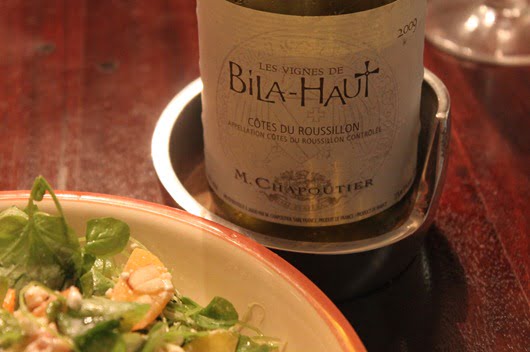
I decided to switch things up a little with this pairing. I’ve been trying to do the “low carb thing” for the last few weeks, and also going forward into the next few months. I figured I needed to drop a lb or three! For this reason, the next few months worth of pairings will probably not feature any type of carb item. Just a friendly warning.
I found the recipe for Chicken and Watercress Salad with Almonds and Feta on bonappetit.com, my new favorite recipe website. I’ve decided that I’m just going to stop purchasing recipe books and magazines, and I urge you to do the same. It seems like such a waste of money when there is so much good content for free on the Interweb!
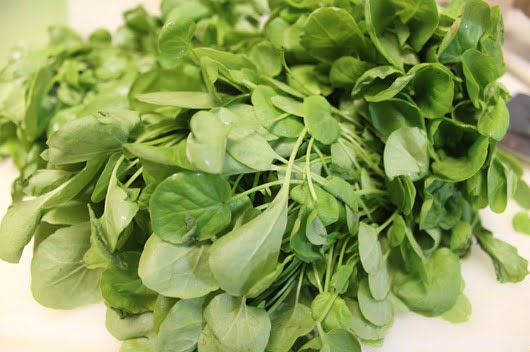
It had already been a long and tiring day at work, so I was in one of those “can’t be bothered to cook” moods. You know what I’m talking about!
The options I assessed were therefore to either go out to eat, or just find a quick recipe and run to the grocery store. Unfortunately, since I live in the East Arlington side of Jacksonville, my restaurant choices are McDonalds, Subway or Golden Corral.
I set my car in the direction of Fresh Market.
This recipe for Chicken and Watercress Salad with Almonds and Feta is about as simple as it gets (in theory). 9 ingredients and a 3 step recipe. 2 of those ingredients were Grapeseed and Almond oil, ingredients that up until this point hadn’t exactly been a staple of the Chislett household. Given than I’m a sucker for cool packaging, I passed by all the other boring bottles of oil and settled on the below two. Now I have probably enough Grapeseed and Almond oil to see me through until the day I die.
The only two hiccups with the dish were that I couldn’t find apricots at Fresh Market, and white balsamic vinegar seemed to be a totally mythical ingredient to the store clerk.
I set my car in the direction of Publix…
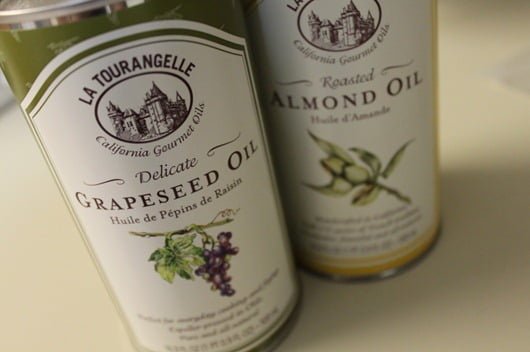
The wine I selected to match was the Chapoutier Les Vignes de Bila Haut Blanc, a blend of Grenache Blanc, Grenache Gris and Macabeu, from the sun kissed Southern Roussillon in Southern France. It’s not a wine I have tasted before, although I have tasted plenty of others out of the Chapoutier line.
Chapoutier wines are easily identifiable by their braille wine labels. The story goes that Michel Chapoutier was watching a TV interview with his friend Gilbert Montagné, a French singer who has been blind since birth. Montagné described the difficulty he had picking out wines by himself in a store, and so in 1994, Michel Chapoutier decided to start labeling all of his wines with braille.
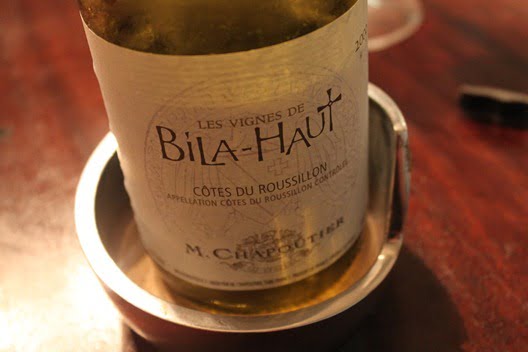
The Chapoutier Les Vignes de Bila Haut Blanc is certainly fruit-forward in style, with ripe apple, pear and citrus dominating, and maybe even a little mango and tangerine. Medium in body, with enough acidity to hold all the fruit together. Very fresh and clean, with a medium finish. I think I paid around $14 for the bottle, which I considered a bargain!

I’ll give the wine credit, it did a great job standing up to the watercress salad! The dish was fairly simple, but made all the better with the wine. I could have seen how a New World wine with too much fruit would have completely overpowered it. The two provided a great pairing, with the wine really picking up on the almonds and apricot in the dish.
I’ll rate this pairing as a:
Perfect Match
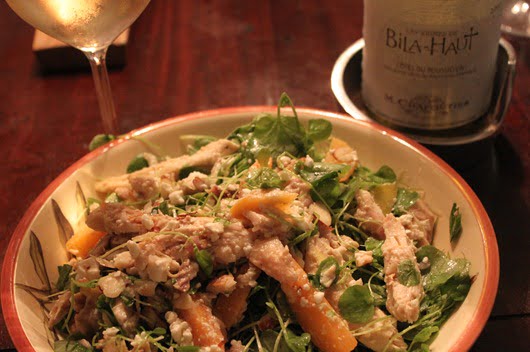
~ My Food & Wine Pairing Guide ~
Bad Match
The interaction of wine and food when tasted together has a negative impact on the senses. This is common when the food item is high in acidity, salt, bitterness, or spiciness.
Refreshment
Many times wine serves simply as a satisfying refreshment to accompany a certain food choice. The refreshment match may be appropriate when the food severely inhibits a good or synergistic wine choice.
Neutral
These pairing situations are average and pleasant, but are missing an element of individuality and thus cannot provide a superior gastronomic experience.
Good Match
In this situation, you have found a wine that matches the food item’s basic components (sweet, sour, bitter, salty) and overall body.
Perfect Match
This essentially means the combined effect of the wine and the food paired together is superior to the sum of the individual parts.
This entry was posted in Pairings and tagged Chapoutier, France, Grenache Blanc, Grenache Gris, Macabeu, Roussillon. Bookmark the permalink. ← Tinto or Tinta? Gary Vaynerchuk and his Daily Grape →














